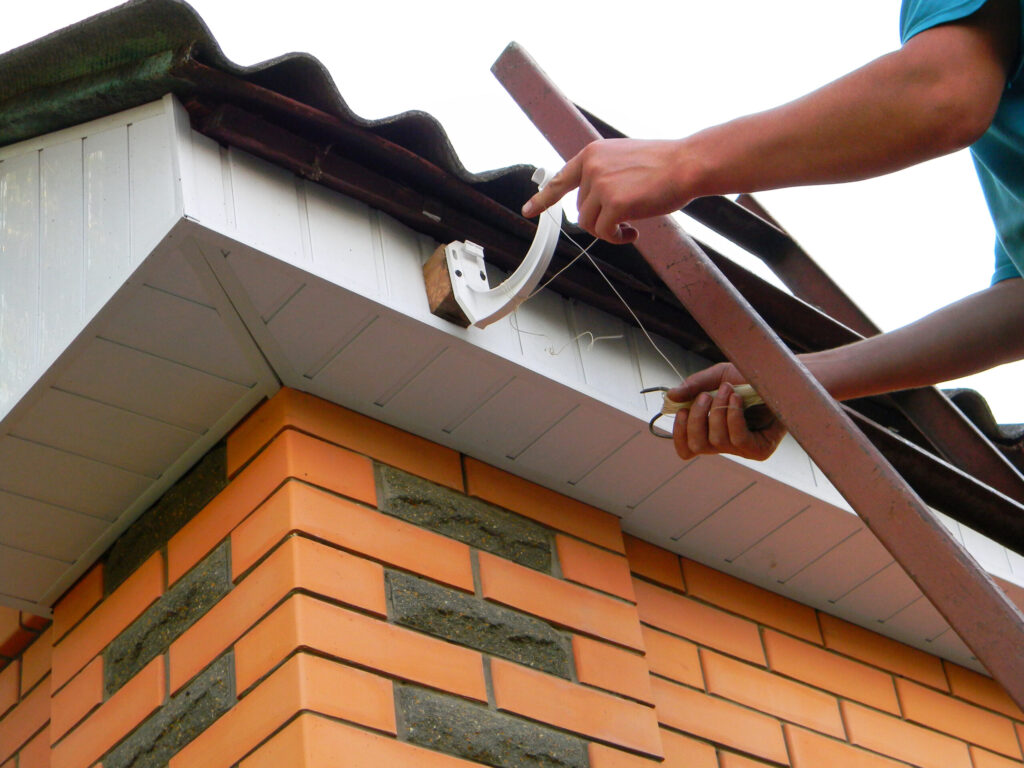
Rain gutters prevent a build-up of hydrostatic pressure in the soil against foundation walls that can lead to wall leaks and structural damage. Gutters also help direct water away from landscaping to avoid erosion and soil compaction.
The slope of a gutter is called its pitch, and it’s important that the angle is correct to ensure proper drainage. This is especially true during heavy rainfalls.
Hangers
Different gutter hangers are designed for specific roof styles and drainage needs, so homeowners need to understand their options before selecting and installing the right ones. Gutter hangers are the brackets that mount gutter sections to your home’s fascia boards, and improperly spaced hangers can compromise the system’s ability to support itself, leading to sagging.
The angle at which your gutters are hung is called the pitch, and it determines how well rainwater flows out of them. Problems can occur if the pitch is too steep or not steep enough. If the pitch is too steep, water moves too quickly through the gutters and overflows; if it’s not steep enough, rainwater sits in the gutters instead of flowing out.
If your gutters are pitched incorrectly, the best way to fix them is by readjusting their slope. Take a tape measure and mark the spot on your gutter closest to your downspout, then move 10 feet closer and make another mark. If the second mark is even with the first, your gutters have the proper slope and you don’t need to do anything else. However, if the second mark is higher than the first, your gutters don’t have the correct slope and need to be readjusted.
Soffit
Gutters are designed to manage rainfall and direct water away from your home. However, if gutters are not pitched properly they may overflow or even damage the fascia and soffit. This is why it is important to regularly check the slope of your gutters. If you notice that the gutters are leaking or overflowing during heavy rains, it is probably a sign that they need to be re-pitched.
To check the gutters, first get on a ladder and look for low spots. If the gutters are sagging in the middle, it is likely because the hangers are too close together and need to be re-positioned. You can also use a level to measure the gutter’s slope. Ideally, gutters should have a fall of about an inch for every 20 feet of gutter length.
Another way to check the gutters is by looking for standing water. If the water is overflowing on the end opposite the downspout, it means that the gutter is not pitched correctly. A good gutter should always be pitched to match the downspout location. Water that overflows the gutter can also attract mosquitoes and create a breeding ground for insects. Standing water can also cause rust or other damage to the gutters and the home’s siding. Lastly, standing water in gutters can create a breeding ground for mold and bacteria, which can pose health hazards.
Fascia
Before you install your gutters, inspect the fascia for signs of rot. If you find rotting boards, you should replace them before installing gutters. This step is important because it will ensure the longevity of your new gutters and help protect your home from water damage.
Once you have inspected your fascia and cleaned it, mark the length of each gutter run using a tape measure and chalk line. This will help you determine the slope of the gutter, which should be about 1 inch for every 20 feet. If the gutter is sloped correctly, water will move down the gutter toward the downspouts.
If you are using do-it-yourself gutters, you may need to cut the gutter sections to the appropriate length. Use a hacksaw fitted with a metal blade or heavy-duty wire snips to make the cuts, and remember to cut an angle around corners. If you are using an aluminum or vinyl gutter, a power miter saw with a carbide-tipped finish blade is recommended for making your cuts.
Many do-it-yourself gutters are sold in 10-foot sections that can be seamed together using special brackets and gutter sealant. Once you have snapped a chalk line along each gutter run, place the seaming bracket on the fascia and screw it in using 1/4-inch stainless steel lag screws long enough to penetrate the rafter tails 2 inches.
Downspouts
The pitch, or angle, at which gutters are hung affects how well rainwater drains away from your home. If the pitch is too low, water sits in your gutters and causes damage to fascia boards, shingles, and other parts of your home. If the pitch is too steep, water moves too quickly through your gutters and can overflow your home’s foundation.
To determine if your gutter pitch is off, you can perform a visual inspection of the gutters. Look at the end of your downspout and locate the lowest point of the gutter run. If your gutter is tilted towards the downspout, this means your gutters are pitched correctly. However, if the gutter is tilted away from the downspout, this indicates that your gutters are pitched too low.
If your gutters are angled towards the house, you can add downspout extensions to even out the gutter load. This will help to alleviate the stress on your gutters and help keep your gutter system functional for a longer period of time.
For long gutter runs, you can also change the pitch of the gutters by changing the slope at which they are hung. For example, if the gutters are currently angled to the left, you can change the pitch to the right by moving the gutter hangers forward by about an inch. This will move the gutter up and down more evenly, allowing water to flow at a more consistent rate.






























